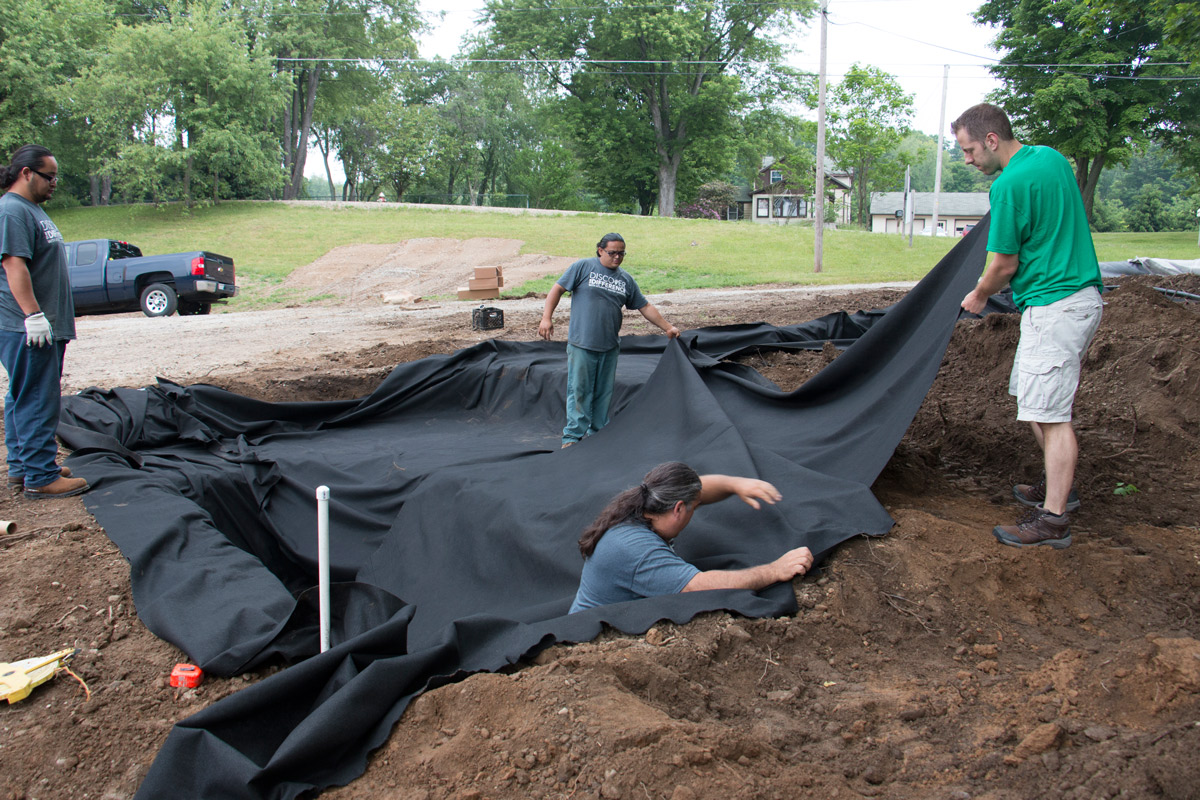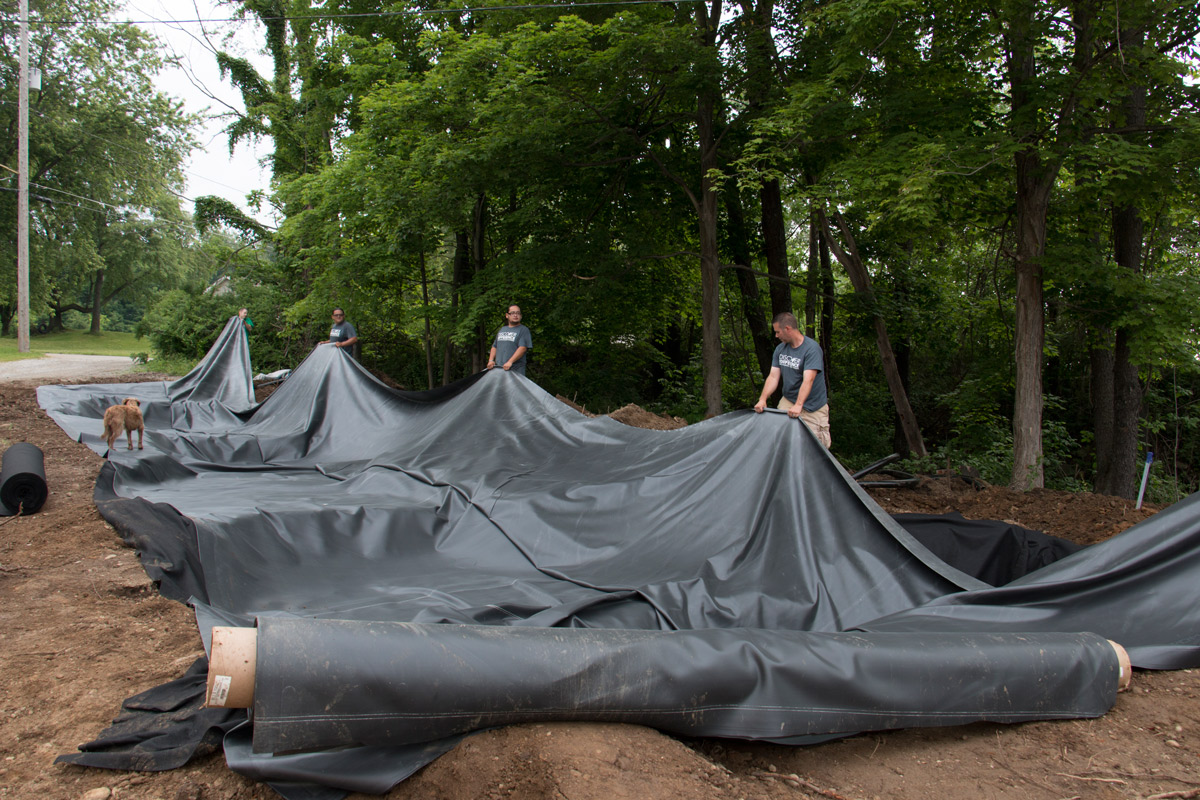Pond-Free 103 Chaper 5
Installing Underlayment and Liner
Once you are sure of the fit, line the excavation bottom and sides with geotextile underlayment to protect the liner from roots and sharps in the soil, then install the impermeable EPDM liner to create the waterproof underground reservoir. If the water matrix blocks you are using have sharp edges or corners, you may elect to cover the liner with another layer of underlayment over the liner before installing the blocks; smoothly radiused edges and corners on the Eco-Blox make this additional step unnecessary. Assemble and install the Eco-Blox or other water matrix blocks and the Pump Vault, aligning them to fit without any spaces between.
Tech Tip - Install a piece of rigid perforated white pipe, 2” to 4” in diameter and a couple of inches taller than the height of the reservoir, inside the liner adjacent to the Pump Vault before backfilling, to act as a sight gauge of the water level. Cap the top of the pipe with a single stone at grade and you’ll be able to remove the stone and look inside to check water level. Don’t use black pipe or you’ll need a flashlight to see the water.
Before backfilling around the reservoir outside the liner, carefully fill around the Pump Vault, inside the liner, with 1” or larger gravel. This will create a void space that will allow water to flow all the way around the Vault, instead of having the liner pressed up tight on the wall of the Pump Vault, which would effectively seal off some of the perimeter of the Vault to water flow. Pull the liner and fabric up over the top of the reservoir to snug them up against the outside walls of the reservoir and to keep dirt from getting into the reservoir. Backfill around the reservoir with clean fill to the height of the blocks. To keep the blocks from getting pushed out of place by too much soil on any one side, backfill evenly all the way around a little at a time, using the handle of a shovel or the round end of a digging bar to tamp the soil down every six to eight inches. When the reservoir is completely backfilled, unfold the underlayment and liner and make sure no folds have been buried during backfilling. Cover the steps with underlayment to keep any sharps or roots in the soil from piercing the liner when heavy stones are placed on top. Whether you’re using one single liner or two (one for the stream, one for the reservoir), spread them out carefully over the underlayment making sure not to carry stones down between the underlayment and the liner as you move the rubber into place. Check for stones and roots once more before starting the rockwork – it’s your last chance to make certain there are no sharp protrusions or hidden problems.


Once you are sure of the fit, line the excavation bottom and sides with geotextile underlayment to protect the liner from roots and sharps in the soil, then install the impermeable EPDM liner to create the waterproof underground reservoir. If the water matrix blocks you are using have sharp edges or corners, you may elect to cover the liner with another layer of underlayment over the liner before installing the blocks; smoothly radiused edges and corners on the Eco-Blox make this additional step unnecessary. Assemble and install the Eco-Blox or other water matrix blocks and the Pump Vault, aligning them to fit without any spaces between.
Tech Tip - Install a piece of rigid perforated white pipe, 2” to 4” in diameter and a couple of inches taller than the height of the reservoir, inside the liner adjacent to the Pump Vault before backfilling, to act as a sight gauge of the water level. Cap the top of the pipe with a single stone at grade and you’ll be able to remove the stone and look inside to check water level. Don’t use black pipe or you’ll need a flashlight to see the water.
Before backfilling around the reservoir outside the liner, carefully fill around the Pump Vault, inside the liner, with 1” or larger gravel. This will create a void space that will allow water to flow all the way around the Vault, instead of having the liner pressed up tight on the wall of the Pump Vault, which would effectively seal off some of the perimeter of the Vault to water flow. Pull the liner and fabric up over the top of the reservoir to snug them up against the outside walls of the reservoir and to keep dirt from getting into the reservoir. Backfill around the reservoir with clean fill to the height of the blocks. To keep the blocks from getting pushed out of place by too much soil on any one side, backfill evenly all the way around a little at a time, using the handle of a shovel or the round end of a digging bar to tamp the soil down every six to eight inches. When the reservoir is completely backfilled, unfold the underlayment and liner and make sure no folds have been buried during backfilling. Cover the steps with underlayment to keep any sharps or roots in the soil from piercing the liner when heavy stones are placed on top. Whether you’re using one single liner or two (one for the stream, one for the reservoir), spread them out carefully over the underlayment making sure not to carry stones down between the underlayment and the liner as you move the rubber into place. Check for stones and roots once more before starting the rockwork – it’s your last chance to make certain there are no sharp protrusions or hidden problems.






